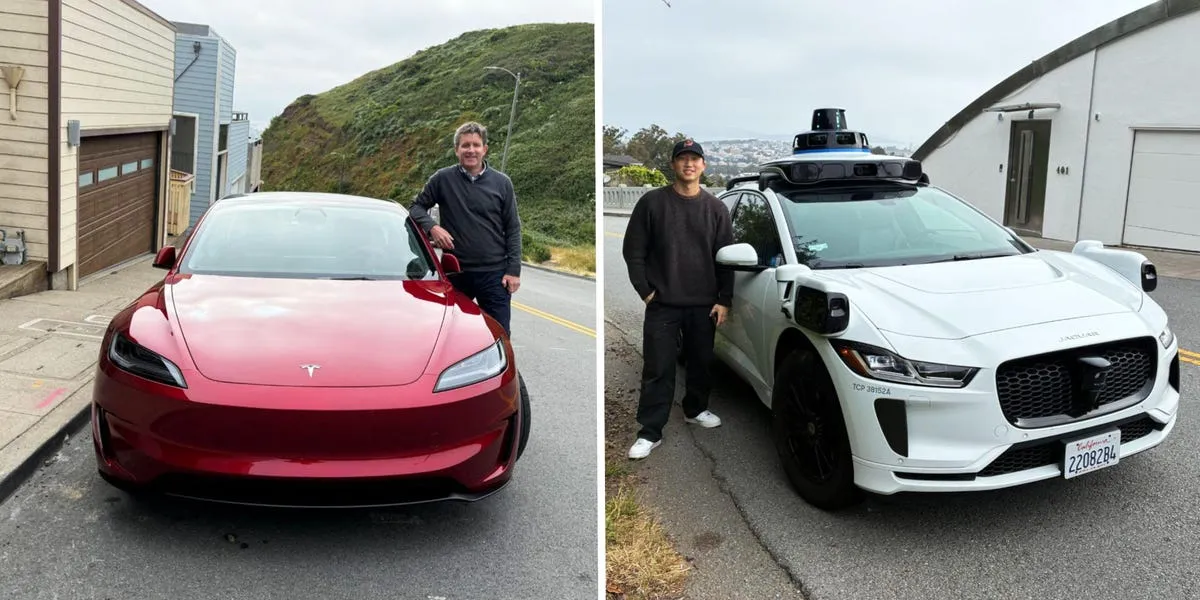
The robotaxi race is accelerating as major players in the autonomous vehicle industry gear up for significant launches. Tesla is set to unveil its much-anticipated autonomous ride-hailing service in Austin next month, while Alphabet's Waymo is actively expanding its footprint in major cities across the United States. At the heart of these innovative robotaxis lie two groundbreaking technologies: Tesla's Full Self-Driving (FSD) system and Waymo's Waymo Driver.
In an intriguing comparison, Business Insider's Lloyd Lee and Alistair Barr tested both Tesla's FSD and Waymo's Driver in San Francisco, leading to unexpected results. Initially, they anticipated that their informal examination would hinge on minor details, such as the frequency of AI hesitations or erratic lane changes. However, the outcome revealed a glaring mistake on Tesla's part that ultimately favored Waymo.
For the test, the duo utilized Waymo's Jaguar I-PACE SUVs alongside Barr's personal 2024 Tesla Model 3. The Waymo robotaxis are outfitted with cutting-edge technology, including the fifth-generation Waymo Driver, which relies on five lidar sensors, six radars, and 29 cameras. In contrast, Barr's Tesla was equipped with Hardware 4 and FSD Supervised software version 13.2.8, featuring eight external cameras.
It's important to note that this software is not the same as the one Tesla plans to deploy for its upcoming robotaxi service, which is expected to use the FSD Unsupervised system—allowing fully autonomous driving without human oversight. Nevertheless, this test aimed to evaluate the current capabilities of Tesla's FSD since its beta release in 2020.
The journey commenced at San Francisco's iconic Twin Peaks viewpoint, concluding at the Chase Center, covering approximately 4 to 7 miles depending on the chosen route. This route was selected for its mix of winding roads and diverse landscapes, including suburban and urban environments. Notably, Tesla's capabilities allowed it to navigate highways—something Waymo's robotaxis are currently unable to do.
The rides were conducted under similar light to moderate traffic conditions, with the Tesla taking its route as suggested by the vehicle's navigation system, which highlighted the highway for the return trip.
Before embarking on their rides, Lee and Barr made predictions regarding the AI drivers' performance. Lee speculated that Waymo would offer a more seamless experience due to its advanced sensor technology, while Barr expressed confidence in Tesla's FSD, citing his extensive prior experience with the system.
Throughout the Waymo ride, the AI exhibited a balance of safety and assertiveness. The vehicle confidently navigated yellow lights and made decisions that felt human-like, such as changing lanes when waiting behind another car at a stop sign. Barr humorously noted that the Waymo Driver exhibited a sense of urgency akin to that of a New York cab driver, emphasizing its commitment to delivering passengers to their destinations efficiently.
Waymo spokesperson Sandy Karp explained that the Waymo Driver continuously assesses its surroundings to make optimal driving decisions, which can include lane changes when beneficial.
Tesla's FSD delivered a largely smooth driving experience, showcasing its ability to signal lane changes and navigate challenging road conditions without sudden braking—an issue that had plagued earlier versions of the software. However, while it effectively handled highway driving, the Tesla did make some notable errors, including a critical incident at the end of the ride.
As they returned to Twin Peaks, the Tesla drove onto a bike lane for several seconds before merging back into the proper lane. Most alarmingly, the Tesla proceeded to run a red light at a complex intersection, a glaring error that raised serious safety concerns. Although the vehicle initially detected the red light and came to a stop, it then inexplicably continued driving, highlighting a significant flaw in the FSD system that cannot be overlooked.
Given Tesla's critical error—one that would likely result in failure during a human driving test—it became evident that Waymo had the edge in this comparison. Although Tesla's FSD demonstrated impressive capabilities on San Francisco's challenging hills and winding roads, the inability to navigate simple traffic signals safely underscored the risks associated with its current technology.
As Tesla prepares to launch its robotaxi service, the potential for serious incidents must be taken into account, especially since human drivers will not be available to intervene in emergencies. While Tesla's FSD may offer advantages in handling routes that Waymo currently cannot, the incident of running a red light serves as a stark reminder of the challenges that lie ahead in the quest for fully autonomous driving.
As both companies continue to innovate in the realm of autonomous vehicle technology, the competition will undoubtedly intensify. Tesla CEO Elon Musk has asserted that the company’s approach to self-driving technology is superior to its rivals, bolstered by the vast amount of real-world data collected from its fleet on the road. The race for the future of robotaxis is only just beginning.